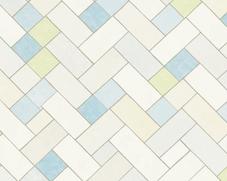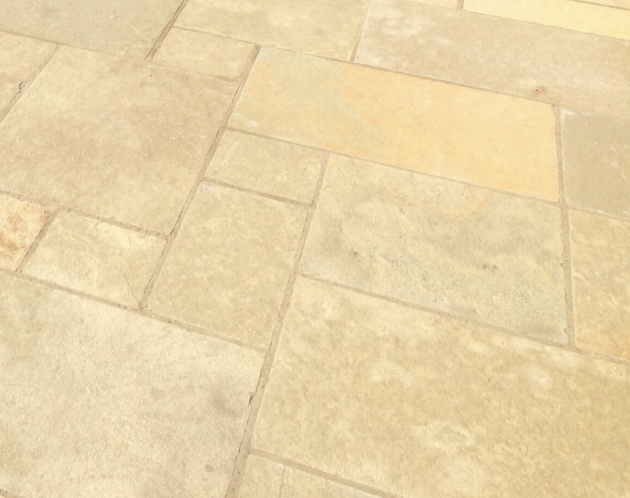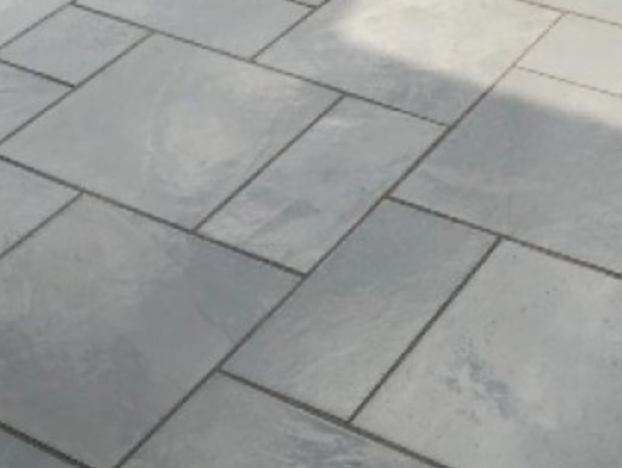What type of patio/paving is best for my garden?
With so many options for paving and patios, deciding which paver is best for your garden can be an overwhelming task. In this guide, we help you make an informed choice. Let’s get started!
What types of patio and paving are there?
In this post, we review some of the most requested patios and pavers customers ask for in the Cotswolds, and others that clients do not ask for so much. These are natural stone (e.g. sandstone, limestone and slate) and manufactured pavers (e.g. concrete and porcelain tiles).
The reason for this selection is not to say which one is ‘the best’ (as you will see, this is subjective and depends on many factors), but to give you an idea of the properties of these products, so you can make your own informed decision.
How do I decide which patio/paving tile is best for me?
When deciding which patio or paving suits your garden, there are some key concerns to bear in mind. As a result, we have decided to review each paving option in terms of the following key areas:
1. Durability (e.g. How long will the patio/paving last?)
2. Maintenance (e.g. How often do I need to clean my patio/paving?)
3. Grip (e.g. How slippery is natural stone in wet weather?)
4. Sustainability (e.g. What paving flags are the most eco-friendly to buy in the Gloucestershire area?)
5. Drainage (e.g. Will the patio gather a lot of standing water?)
6. Aesthetics (e.g. What type of patio/paving looks best in my garden?)
7. Cost (e.g. What are the cheapest and most expensive pavers for a garden?)
In the following sections, we discuss things to consider about these key areas, compare different paving and add some final thoughts. We also include a table at the end for quick comparison. Here is a list of contents to help navigate the guide:
Contents
1. Notes on the key areas
- Durability
- Maintenance
- Grip
- Sustainability
- Drainage
- Aesthetics
- Cost
2. Natural Stone
- Limestone
- Sandstone
- Slate
3. Manufactured Pavers
- Wet Cast Concrete
- Porcelain Tiles
4. Conclusion and Table
1. Notes on the key areas:
Durability
Advice on durability is general in this guide but gives you an idea of the differences between paving types. Variations of each type of paver (e.g. quality and finishes) alongside how much exposure they have to certain weather conditions widely affect durability in terms of things like cracking and fading.
The most important thing to add is that no matter the quality of the paver, if it is laid badly with a poor substrate, a patio or path will not last. At Greaterscapes, we pay attention to detail at every stage of your paving installation to ensure enduring and beautiful paving that is an asset to your garden.
Maintenance
The times we recommend for sealing, cleaning, repointing (the filling or repairing of joints in paving) are general recommendations. These times will vary depending on the specific type of paver (e.g. one type of limestone vs another), the quality of the mortar or grout and your patio’s exposure to the elements.
Grip
The recommendations for grip will also vary. For example, a riven or textured sandstone slab will have very good grip in wet weather, but a smoother one will have less. As a result, we have made comments about the types of paving grips to give you an idea of their capacities.
Sustainability
Sustainability depends on the energy intensity and emissions created in the process of obtaining or manufacturing the paver. Furthermore, it depends on where it comes from – a locally produced concrete could potentially create fewer emissions than a natural stone from a distant place.
Drainage
Gloucestershire has a wet climate with a variety of soil types, including clay, which is poor for drainage. Consequently, it is important to note that despite what we say about each individual type of paver, sound drainage is a vital consideration for the installation of any paving to prevent pooling and prolonged standing water that may stain or damage it.
There are many additional draining options, such as channel drains and flow drains. However, it is paramount that you install your patio with a fall (a slope that carries the water away) at ratio of 1:20. At Greaterscapes, we pride ourselves on the high-quality groundwork we put into our paving jobs, ensuring you have durable, stunning paving with excellent drainage.
Aesthetics
The look of a patio or path is largely down to personal preference. However, you should think about how the paving we discuss below fits the architecture of your garden and house. Ask yourself questions like, “Do I want a modern garden?” Or, “Which paving slabs go best in a country garden?”
Cost
The planning and preparation for the groundwork of your patio (such as drainage preparation) is where you will spend the bulk of your time or money. Therefore, when it comes to choosing a paver, budget permitting, the cost difference between slabs is not where most of your money or time will go. Spending more on slightly dearer pavers will be worth it if you intend on having a patio or path in your garden for a long time.
2. Natural Stone
When it comes to natural stone, there are many different types on offer. We discuss some of Greaterscapes’s customer favourites (click here to look at some we have laid in Gloucestershire) and their pros and cons.
Limestone
1. Durability: Overall, it is a very durable material. Although porous, allowing water to get into the stone, it is still very resistant to cracking from frost or heat changes, especially if it is high-density limestone. It does fade in sunlight over time, but most say this improves its patina effect.
2. Maintenance: Limestone needs regular sealing (every 2–3 years) and proper cleaning (with a power hose) at least once a year to prevent staining and algae growth. All patios require regular sweeping and hosing to keep them in excellent condition. Repointing should happen every 10–15 years and weeding fairly frequently.
3. Grip: This is excellent in dry weather but can become slippery when very wet or after polishing. However, if limestone is honed (matte finished) or riven (textured), it has great slip resistance in any weather. This is true of all natural pavers. Bear in mind that any paver is slippery in icy weather.
4. Sustainability: Cotswold limestone is quarried locally, which is a great choice for sustainability. Check with your supplier to see whether it is from the UK or imported. The latter is often of poorer quality and lower in density.
5. Drainage: Due to its porosity, limestone is a good choice for natural through drainage and prevents some standing water from gathering. However, when it absorbs too much water, low surface run-off and pooling can stain the surface. However, as mentioned earlier, proper installation of the patio prevents this.
6. Aesthetics: Soft, uniform tones of cream, honeycomb and grey create a lovely, rustic feel in a garden – popular in the Cotswolds.
7. Cost: Limestone is mid–high range in price. The cheaper it is, the more issues one has with durability and drainage. Quality limestone is a very good long-term investment because of its longevity.
Popular types and prices:
Riven limestone (kota blue): around £23 per ㎡
Egyptian limestone: around £40 per ㎡
Cotswold stone: around £50 per ㎡
Sandstone
Indian sandstone
1. Durability: This stone is highly weather-resistant and highly unlikely to crack in Gloucestershire weather. Although it is more porous and less durable than limestone, it is an incredibly robust material out of the box. Buff and yellow tones are more susceptible to fading in areas with intense sunlight year-round.
2. Maintenance: Like limestone, porosity means it needs sealing to prevent staining (every 2–3 years) and cleaning properly once a year. The porosity may lead to more algae build-up, which is also the case for limestone. Repointing should occur every 8–12 years and weeding is fairly frequent.
3. Grip: Textured surfaces have a very good grip, even in wet weather – the smoother the sandstone, the more slippery it becomes.
4. Sustainability: Varieties such as Indian sandstone are imported, so if your garden’s carbon footprint is a concern, check with the supplier to see how far it has travelled.
5. Drainage: Like limestone, sandstone is naturally porous but slightly more so. As a result, there will be similar concerns with drainage: good for through-flow but less good for surface run-off.
6. Aesthetics: There is a wide range of textures and colours for Indian sandstone, meaning it can suit a variety of architecture. Think contrasting or muted tones of pink, cream and grey. You can go for something more uniform in one colour or create interesting designs with varying shades and hues.
7. Cost: It’s an affordable material, but costs vary depending on colours and finishes, moving towards being expensive.
Popular types and prices:
Indian sandstone (autumn brown): around £20 per ㎡
Indian York sandstone: around £23 per ㎡
Mint fossil sandstone: around £26 per ㎡
Slate
Brazilian slate
Slate is a less popular natural stone option in Gloucestershire gardens but offers a distinctive and powerful look in an outdoor space. There are many options for slate, but here is one we like:
1. Durability: Slate is the most durable of the materials listed on this post. It is extremely dense and handles any freeze-thaw weather that the Cotswolds may throw at it. It is also extremely resistant to fading from sunlight.
2. Maintenance: Slate can be liable to scratching, so choosing a good sealant is important. Sealing should be done every 1–3 years. A thorough clean should be carried out twice a year to prevent staining and algae growth. Repointing only needs to happen every 15–20 years due to slate’s excellent durability. If the joints are tight, weeding is minimal.
3. Grip: Its natural-grain texture can provide excellent grip when wet. It also has fantastic grip in dry weather.
4. Sustainability: Local varieties, such as Welsh slate, quarried in North Wales, have a low carbon footprint and is therefore, combined with its durability, a highly sustainable choice.
5. Drainage: Slate is impervious, so it has excellent drainage for surface run-off. As a result, this water needs somewhere to go, so proper drainage should be incorporated into its installation.
6. Aesthetics: Slate can be cut into perfectly squared tiles to suit a more modern look. Alternatively, it is a great material for a more rugged, rural aesthetic in a garden. The subtle blues, greys and pinks in slate’s blackness create a dramatic effect in any garden.
7. Cost: It is the most expensive option on the list, but its high quality means it is a good long-term investment. There are alternatives to slate such as black limestone, but these become scuffed and marked easily, so buying Brazilian slate may be an affordable option. Welsh slate is more expensive.
Popular types and prices:
Brazilian slate: £38–60 per ㎡
Marshalls slate paving: around £70 per ㎡
Cotswold stone: £45–75 per ㎡
3. Manufactured Pavers
There is a myriad of concrete and other manufactured paving selections available on the market in Gloucestershire and the surrounding area. They serve as a very good functional and decorative option. Here are a couple of popular options with some of our customers. Click here to see some we have installed.
Wet Cast Concrete
Stamford riven concrete
1. Durability: As the concrete is manufactured, it is engineered to last and very resistant to cracking if it is laid correctly and well made. Moderate fading appears over time in areas with a lot of sunlight. However, UV protection is engineered into some concrete slabs, which prevents fading. Check with the manufacturer.
2. Maintenance: Sealing is optional (every five years) but recommended if you want to avoid algae build-up on your patio. You should clean it properly once a year. Repointing can be needed every 5 years, but weeding can be less frequent if the joints are tight.
3. Grip: The grip on these slabs is typically textured, so it is very good in all weather, except icy conditions.
4. Sustainability: The production of concrete produces high amounts of carbon dioxide, making it an unsustainable product. To reduce its carbon footprint, be sure to order locally.
5. Drainage: It is very good for surface run-off and will need to be laid with a fall and a more absorbent sub-base as a result. This also applies to slate and porcelain: a higher density means less through-flow. Wider pointing is an option to increase through-flow drainage, but this may add to maintenance due to more weeds getting through and mortar chipping over time.
6. Aesthetics: It has a uniform and functional appearance that can appear cheap and artificial at the bottom end of the pricing spectrum. However, at the higher end of the price range, one can find a range of colours and imitations of natural stone products.
7. Cost: Prices start off as being very affordable, but at the higher end of the market, costs can go above what you would pay for natural stone. If price is the main concern, dry cast concrete is a lot more affordable but extremely limited in colours and finishes – it is often only used for non-decorative purposes.
Popular types and prices:
Indian York sandstone: around £23 per ㎡
Marshalls Saxon paving: around £50 per ㎡
Porcelain Tiles
Porcelain
Porcelain has become extremely fashionable over recent years for those who want a garden with a more modern appeal. Click here to see some patios that Greaterscapes laid using these tiles.
1. Durability: With proper installation, porcelain tiles can last for many years. They are frost and heat resistant due to the density they gain in the kiln-firing process. Overall, a very robust material.
2. Maintenance: They are stain-resistant and easy to clean. The only thing that needs to be sealed is the grouting to prevent hazing. Repointing occurs every 10–15 years and weeding is minimal with tight joints.
3. Grip: These tiles have an excellent grip in all weather (except icy conditions) in a range of textures and finishes.
4. Sustainability: Locally sourcing porcelain tiles improves sustainability, but their manufacture is energy intensive and produces high emissions.
5. Drainage: They are impervious so have excellent surface run-off. Proper preparation is needed to prevent pooling and prolonged standing water damaging the tiles.
6. Aesthetics: Their clean finish looks great with modern builds and/or suits customers who like a minimalist aesthetic in the garden. A wide variety of colours and textures also offer a choice of styles that suit a variety of architecture.
7. Cost: Price is mid–high. However, they will be a sound, long-term investment.
Popular types and prices:
Strata ‘Sansar’ volcanic beige: around £30 per ㎡
Talasey porcelain ‘Vitripiazza Anno’ Grigio: around £40 per ㎡
Alwick beige stone effect: around £60 per ㎡
4. Conclusion and Table
Although this is not an exhaustive list, we hope this post has given you some useful information for helping you choose which pavers are best for your garden. The truth is that, practically and aesthetically, the best option for you depends on where you live and the issues that presents e.g. soil porosity, position of the garden, architecture of the buildings, etc.
For example, in terms of durability and aesthetics, if you have a south-facing garden (one that gets the most sunlight in a day), you will want something that doesn’t fade so much over time in the sun, such as slate, or looks better, like limestone. Below is a table to help you compare the pavers discussed more easily. Please feel free to contact us or give us a call (t. 01453 752 797 or m. 07841 595 583 for any installation and maintenance enquiries you have for your paving and gardening needs.














